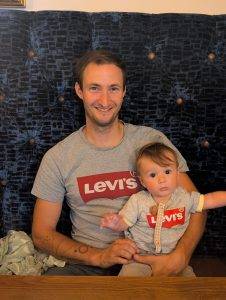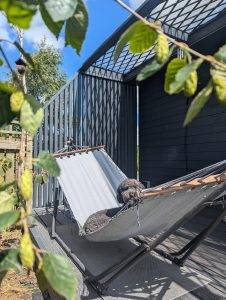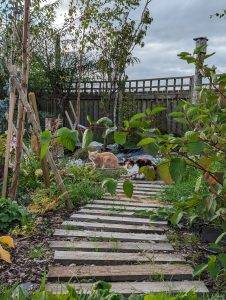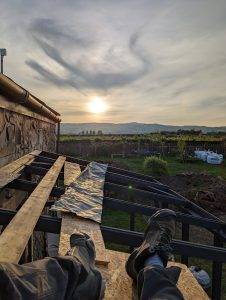Don’t put off having a great lifestyle until after you’ve “made it”.
Remember we’re building a lifestyle business here….
The act of building your ideal life happens one single day at a time.
and Solopreneuring is all about the lifestyle.
What you do every day = your life
Some people asked me how I fit it all in, and it’s important to remember that I don’t.
I choose which tasks I fit in.
Also, many of my tasks that “only take 15 mins” are because I have built an automated system, or trained a team member to do them really effectively.
I’ve recorded a video walkthrough of this exercise for my subscribers, you can get access below…
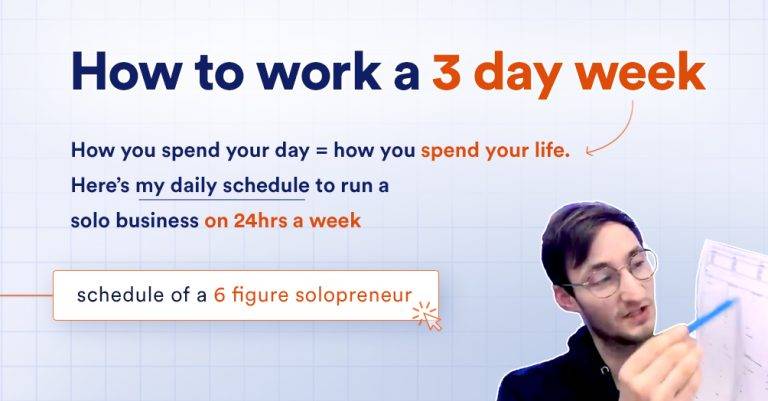
I'm running a 25min masterclass with a breakdown of the daily schedule I use to run a £20k/m business on a 3day workweek
Subscribe for instant access to 6 figure solopreneur schedule template.
- 0:00 How to plan in years act daily
- 1:20 From grand goals to daily actions
- 1:50 Change your mindset on overwhelm
- 2:00 The reward for success is more work
- 2:40 Planning down to hourly level
- 3:20 Managing expectations on success
- 5:30 Theme your days
- 7:30 Non-negotiable life admin
- 8:00 Removing overwhelm
- 8:30 Your most important thing
- 9:20 Deep work vs Shallow work
- 10:00 Ritualize your focus
- 11:00 Bake in freedom and downtime
- 14:00 Habit tracking
- 14:30 Wind down and Weekly review
- 15:10 Use a printed schedule, set intentions, revise as you go
- 16:15 Run through of my “ideal” schedule
- 19:40 Set aside a self day to zoom out.
- 20:30 Do the work and get out early
- 21:20 Leave 50% gaps for wiggle room
- 21:50 Parkinsons Law – Time chunking
It all starts with simple actions every day.
As creatives, we spend all day designing things,
You can apply your skills to create a new vision of your life,
And reverse engineer a lifestyle business around your lifestyle.
In the next 5 mins I’ll share the schedule I use to keep myself on track, and working on the right things everyday.
You need to become someone who takes imperfect action.
You need small actions to compound over time.
How to plan in years, but take action every day
Action doesn’t mean changing your whole life overnight, or committing to grand gestures.
Life isn’t a sprint or a marathon. It should be a stroll in the park.
Few can get up and run a marathon. But anyone can take a few small steps every day.
Life is not a sprint or marathon. It should be a stroll in the park.
You’ve got to enjoy your life that is the whole point of having a lifestyle business.
If you want to grow a lifestyle business,
We need to plan in years, but take small actions daily.
It starts with planning your day.
What you do every day becomes your life.
what do you WANT every day to look like for the next 5 years?
what do you NEED to do every day to get to where you want to be?
Now put that into a daily schedule.
BOOM, you’ve got your ideal lifestyle and you’re working towards it one day at a time.

A good schedule = a good life
So now you know how to turn your yearly goals into daily steps, but knowledge without action is just potential.
I’m gonna show you how to plan in years but take small actions daily to steer your life in the direction that you want.
It all starts with planning your day. So, the theory behind this is what you do every day becomes your life.
So we’re going to take all of those actions that we took in the previous step, your grand goals, your big visions of what you want your life to look like.
Once you’ve got your daily schedule there, we’re just going to work on it one day at a time. It really is as simple as that.
It isn’t always easy.
We live in the real world.
There is always more to fit in.
So you’ve got to remember to be easy on yourself.
But you don’t need a way to get through more tasks.
There will always be more tasks.
You need a way to keep yourself working on the right things,
and get out at the right time .
If you stick to the schedule, for the most part, you’ll be moving in the right direction, whilst still having a life,
and living the life you want…
In fact, I boil what little success I’ve had down to repeating these x6 activities every day at the same time.
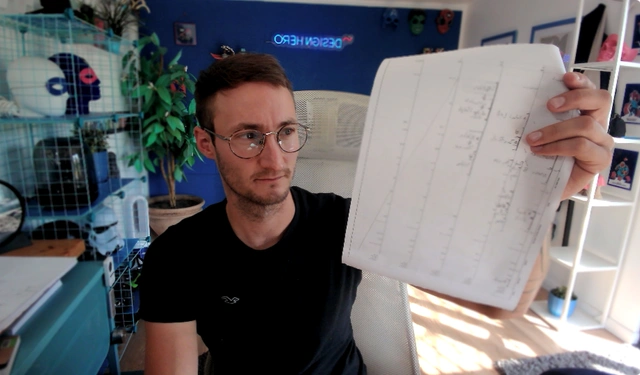
Why is it important to plan your freelance schedule down to a daily and hourly level?
So the reason I make you watch the lifestyle design training first,
is to understand that time is your most important resource.
The great irony of success in a lifestyle business:
As you become more successful in your niche,
there’s going to be more demands on your time.
Remember our goal is a business which gives us freedom!
Many people don’t plan their day, and then wonder why they spend their day fighting fire.
Most people default to organizing their day out of their inbox.
Your inbox is a list of other people’s priorities.
If you’re working on other people’s priorities
You’ll never make time to work on yourself.
Now time is different for everyone.
I consult for 6 and 7 figure business owners and single parents who are working full time.
You can only control the areas you have agency over.
So don’t stress. It may just take you a little longer.
Don’t listen to the gurus, slower is totally fine.
They all quote their overnight success.
How would you define your timeline anyway?
when I started sidehustling?
when I went full time at Design Hero?
when I had my first 10k/m?
Everyone has a different amount of freedom and time.
This will be faster or slower for some depending on your situation.
There is no correct pace.
Don’t let anyone tell you what success looks like.
This is your life.
How to design a daily schedule for a 6 figure lifestyle business with freedom baked in.
Most people default to the 9-5. It’s an outdated model of work if you are a knowledge worker.
As a remote worker, there is no reason why you should tie yourself to an outdated mode of work.
Organize your week, however it works best for you.
Further down the page you can subscribe to get a free video training, plus a plug-and-play template to build your own schedule.
Here’s a breakdown of my schedule for systematic solopreneurs.
This is just what works for me. You’re going to customize it to yourself.
I’ve been experementing with stuff to make a 4 hour workday stick
But now I’ll run you through how I run a multi 6 figure agency on a 22 hour work week.
Theme your days
I theme my days.
The reason why I do this is to reduce context-switching, and work on similar tasks for efficiency.
- Monday, when I have my most energy I work on big-picture tasks. That’s the things that grow the business and generate more profit or save time in the long run.
- Tuesday I do “maintenance” or “fulfilment” work. This is work that fulfils my responsibilities, and makes money in the short-term, but doesn’t necessarily grow the business. Working on jobs, keeping clients happy.
- Wednesday is when I focus on my education business, Life by Design, I write, I review marketing, I make strategic decisions.
- Thursday is calls. It’s kind of the last day that I worked during the week and it tends to be when my energy is lowest, so I take calls.
I take client calls, sales calls, feed consultations, and in-between I tidy up things that have run over during the rest of the week. - Friday, This is a self day. This looks like it’s an empty day, but actually, this is one of my most important days. People will judge you for this. They’ll call you lazy or say you lack drive. I protect this time carefully. This is where all of my best ideas happened. This is where my strategies get made. This is where I do my big thinking, and this is where I recuperate so that I’m at my best for the other four days.

Theme your hours
So you know I theme my days. I also break parts of the days into themes:
- Mornings are for deep work.
- Afternoon is for shallow work
- Evenings are for winding down.
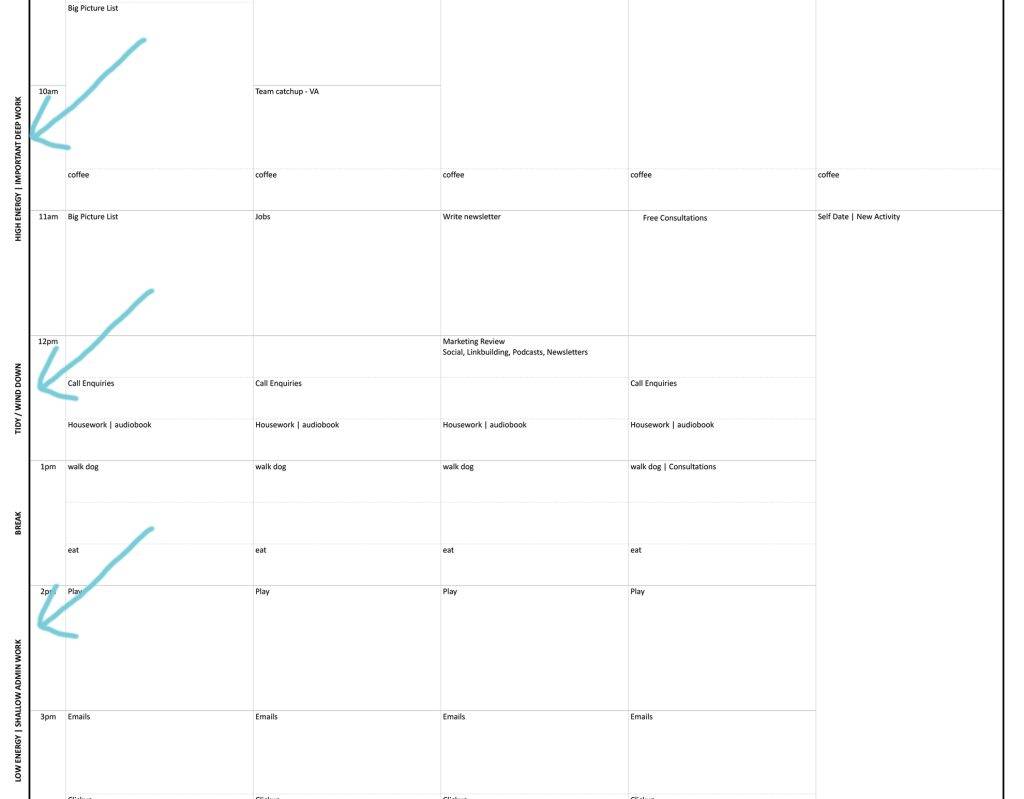
Mornings – Deep Work
In the morning, I do deep work.
If this is a foreign concept to you, I strongly recommend reading Deep Work or Flow.
Both of those books are phenomenal books that would change the way you live and work and think and will basically give you the superpower to get more done in two hours than most people do in a whole work day, especially if you nurture that habit. It is a skill that to learn it takes years to get into a proper work habit.
It’s almost like a ritual. It’s basically when I come into my office in the morning. This is my home office.
It’s been five months building it. I’m very proud of it. It’s in my garden surrounded by nature.
When I come in I have a ritual I’ve nurtured:
- I turn on the lights.
- I take off my shoes and put on slippers
- I turn on my speaker.
- I spin my zen s and thingy
- I switch on my computer
- I hide my phone in a drawer
- I tidy my desk
- I turn on Freedom to block distracting apps and websites.
- I use to facilitate deepwork is Brain.fm which puts your brain into a pattern of super focus.
- I set a timer
- I write down my MIT (more on that later)
- I work on my MIT with super focus until the timer is done.
Breaks
Then I have a little wind-down period. After a deep work sessions, your brain’s gonna need a rest.
We live in the real world, you’re not a robot.
I allow myself to be distracted during set times.
Do something mindless; Grab a coffee, take a dog out, do some housework, listen to a book.
I allow a few minutes for checking Instagram going on YouTube. But I use focus mode to limit myself to 5 mins to prevent mindless scrolling.
I do the housework and life admin while listening to audiobooks.
Personally, I prefer to do something physical to change up your brain activity.
I will do “thinking” work for 2 hours, then I will do “physical” work. Get outside and do some gardening, workout, empty the bins etc. This allows different parts of your brain to rest.
Afternoons – Shallow work
Nothing productive or great happens after 1pm 🤣
The best bit of your energy is already spent.
The second part of my day is what I call low energy or shallow work.
This is for maintenance and admin tasks that basically keeps my business running, but doesn’t grow the business.
I run through my emails and I action any emails I go through my click-up, and project management tools. I engage on LinkedIn.
Wind Down
Towards the evening I tidy up and wind down.
If there are any unfinished tasks, these create a mental nag on your brain.
So I “close the loop” by noting them down in my list for another time.
I have another ritual to wind down the day, I’ll read a book in my beanbag for 10 mins.
When I finish I’ll close down the office, turn off the lights, ring my chime and say “that’ll do donkey” so that my brain knows I’m done and it’s time to switch off.
Use a printed schedule
Online calendars are great, they sync with scheduling tools and keep you organised.
But I always use a printed calendar for my daily schedule.
I print a prefilled schedule with vague headings like “marketing” or “big picture task”,
then each day I write in the specific tasks like “write social posts” or “revise enquiry email sequence”.
As you go through the day you can score out completed tasks.
Revise as you go
We live in the real world. You will not stick to your schedule.
Things will come up. Someone will knock the door, the post will come, your phone will ring, something will happen, and your schedule will get knocked out.
If you don’t get your scheduled task done, then revise your schedule each time.
It may seem pedantic, but it’s more important to have a plan, than to stick to the plan.
Having a plan means you work intentionally, instead of reacting.
So every hour I update my schedule and see where I am, I write the next task in, I score at what was off, and move things about.
You may also find that every month or so you need to recheck and revise your schedule to take account for new patterns or new objectives and goals.
Schedule time to think
I think a little bit every morning: One of first things I do every morning is walk the dog. I use my morning walk as I think through the day and let my mind sort information. If I find my mind wandering I nudge it back to the task of sorting and planning the day.
But I also think more deeply every Friday.
I take Fridays off to take a step back, do some learning and think big picture stuff, strategy, review life and business goals, make sure I’m on track and working on the right things.
I also make time for myself on Fridays and try to do something new or refreshing. I’ll go hiking, I will hire a dinghy, try something I haven’t done before like horseriding or something. New inputs lead to new perspectives.
Nail your morning routine
This is another thing productivity gurus like to talk about. But this one actually works 🤣
Having a regular routine keeps me sane, and allows you to operate on autopilot, freeing up your brain to work on other tasks like planning the day.
Having a strong routine reduces choice overwhelm.

Block out your non-negotiables
If you have other responsibilities, the first thing to do is plug them into this calendar.
If you need to walk the dog in a morning, if you need to take your kids to work, whatever it is, plug these into the calendar and block off those times so you can’t fill them up.
Then add in the things you’re going to do every day or every week to achieve your long term goals:
Everyday I get out a walk.
Everyday I call enquiries.
Everyday I engage on LinkedIn.
Everyday I check my team has everything they need.
Each takes only 15mins, but each keeps my business running and growing.
These daily actions keep my life moving in the direction I want
Weekly Theme
I chart a weekly theme for each week. This is usually part of a larger long-term goal I’ve got going on such as “team training” or “LinkedIn Growth“.
The purpose of this is to remind me of what I should be working on.
It’s easy to lose sight of this as the week drags on.
Usually I have a weekly task that kind of runs through the whole week. So I’ll checkin with that to make sure that I’m working on it every day, because if you don’t do that, you’ll forget, and you’ll get distracted, and your daily thing will be random, whatever occurs to you.
Most Important Thing
At the top of each day I write down my MIT or “most important thing”
This is the one task that I want to get done today.
Being a solopener is having x100 things to do every day and only getting x1 of them done.
So this is where I write the one thing I’m going to get done that day.
After that, I write x3 bonus things it would be nice to get done.
So long as I get my MIT done, the day is a win, anything after that is a bonus on top. I’m not going to beat myself up if I don’t get other things done. There’s always tomorrow. It’s more important to get out and enjoy life.

Daily Review
At the end of each day I do my daily review.
- I make sure that I’ve done my most important task.
- I check how I felt about the day.
- I review my weekly goal
- I plan tomorrow
- I check my daily habits (I use a phone app)
Habits Checklist
The last thing I do is my habits checklist.
This is a mix of work and personal stuff.
Exercise, chores, growth tasks such as reading…

Time-chunking
Task expand to fill to fit the time available. Set time limits on yourself to get things done quicker. Here’s how:
Chunk in your day into 20 min slots, that you fill up with a task.
Set yourself a fixed time to work on these things. Try using a Pomodoro timer.
only work on that task for the time you’ve set aside.
If you’re working on a project, don’t sit with your emails open.
If you’re doing emails, only work through emails then close it.
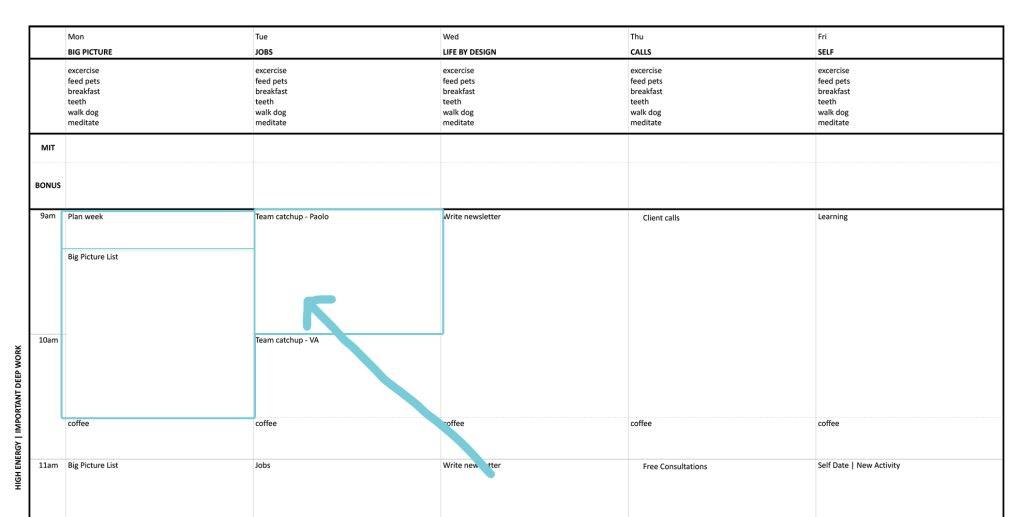
Leave gaps
Do not be tempted to fill every block of your calendar, leave gaps in there for unexpected stuff. Leave gaps for downtime to reset your brain, take a walk, to get a coffee, and for unexpected stuff.
Want a deep dive on schedule design for solopreneurs?
I hope that helps!
The point of this exercise is to help you spend the time you do have intentionally.
What I find is that most people are really only productive about 10% the time.
The goal of this schedule is to help you do the work, stop and get out.
If you don’t follow schedule, you’ll just continue working.
Many of my students are self driven, self-starters, and they’ll just continue to work until they’re totally burnt out.
This really helps to not just to help you grow the business, but also to hold your account was a lifestyle business and still have a life outside of your work.
So I really hope that was helpful.
Some people asked me how I fit it all in, and it’s important to remember that many of my tasks that “only take 15 mins” are because I have built an automated system, or trained a team member to do them really effectively.
I’ve recorded a video walkthrough of this exercise for my subscribers, you can get access below…
Get my template week plan for freelancers

I'm running a 25min masterclass with a breakdown of the daily schedule I use to run a £20k/m business on a 3day workweek
Subscribe for instant access to 6 figure solopreneur schedule template.




